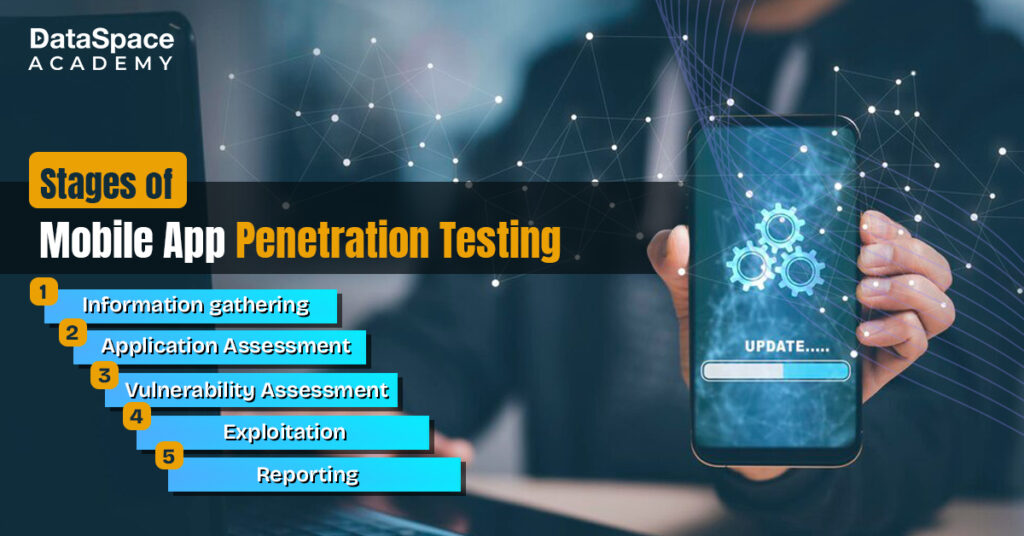Mobile Application Penetration Testing - Overview, Stages, and Benefits
Last Updated : 28 Feb, 2024
 1.33L
1.33L

Introduction
Over 80% of mobile apps are susceptible to cyber threats.
An average mobile phone houses 30+ mobile apps, if not more. From booking tickets to paying electric bills to shopping hauls, mobile apps are a constant now for almost every chore. This accelerating rise in app usage has also put cyber attackers on high gear. Put simply, your mobile apps might be vulnerable to cyber attacks. And this calls for mobile application penetration testing.
Cutting through the tech jargon, mobile app penetration testing is a security test that detects security flaws in mobile apps.
Here goes an extensive discussion on penetration testing on mobile apps.
Overview
Penetration testing is carried through a simulated attack on a device to detect its security vulnerabilities. Mobile app pentesting is the same simulated attack on mobile apps, executed with the intent to probe into their security gaps.
Added to vulnerabilities, the app pentesting method also brings to light the bottlenecks that might hamper optimum security for the apps. Summing up, the penetration testing procedure offers clarity on the current security posture of mobile apps, and the mobile ecosystem in general.
When do you need to run mobile app pentesting?
Some of the common scenarios that determine the need to carry out mobile app penetration testing include the following:
- Before launching an app
- A new update
- Incident response
- While checking compliance requirements
- Integration with third party apps
- Security audit events
- Modification in underlying codebase
- Growth in user base
Phases of mobile application penetration testing

Let’s dive into our mobile app penetration testing step by step guide:
- Intel gathering
- Application assessment and understanding
- Vulnerability Analysis
- Exploitation
- Reporting
To begin with, you have to study the architecture and design of the application to gather information about its existing security posture. The research will help to define the scope of the penetration testing, functionalities, and potential vulnerabilities.
Every mobile application works in a different manner and hence it is important to find out the specific steps for information gathering. The tester will especially look into how applications are able to connect to the backend server and operating system.
Nest, the tester will work to find out the potential security vectors in the app to identify probable impact of security breaches. S/he will also have to find out how the app stores sensitive information and how it transmits data.
The most crucial stage of pentesting, this is where the pentester will run an in-depth scan of the app to detect vulnerabilities. They deploy multiple mobile pentesting tools to find out security issues like authorisation flaws, authentication issues, unsafe data storage etc.
Once the tester has listed down the vulnerabilities, the next step is exploitation. This is where the tester launches the simulated attack to exploit the vulnerabilities. It will help to fathom the potential impact of a cyber attack on the app.
After successful completion of penetration testing, the tester will draft a report on the details of the vulnerabilities. And it does not end there. S/he will also have to provide necessary recommendations for mitigation strategies.
You can sign up with our penetration testing certification program to learn mobile app penetration testing from industry experts.
Benefits of mobile penetration testing

Some of the benefits of mobile penetration testing include the following:
- Comprehensive assessment of security posture
- Prevention of future attacks
- Enhances overall security
- Improved app credibility
The penetration testing process renders a reality check on the app’s existing security meter. It serves as a security warning, nudging the app users/developers to take remedial actions fast before it’s too late.
This line comes in tandem with the line mentioned above. The pentesting report not only lists down the vulnerabilities but also remedial measures to prevent future attacks.
Mobile app penetration testing is a continuous improvement process that is aimed to elevate the security of the app as well as the app user. The updated version will carry security patches found in previous version, and will boast higher level of security.
Penetration testing at periodic intervals is more than compulsory if you have an app for your business. Continuous security monitoring will improve the security posture of your app and eventually its credibility before your customers.
Conclusion
Mobile app penetration testing plays a key role in fortifying overall security of the mobile apps and protecting the overall mobile environment. As apps carry volumes of confidential data today, the testing is also vital to shield your sensitive data. DataSpace Academy gives an opportunity to learn about the mobile app penetration testing through hands-on training. We also offer penetration testing course for C|PENT certification training for global certification in pentesting.
 1.33L
1.33L





































































































